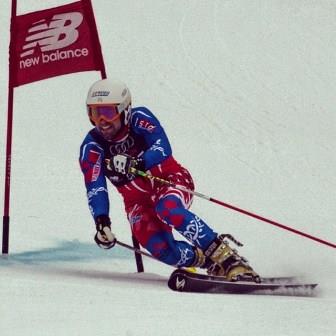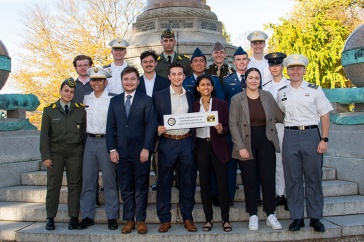Here’s the glory of being a reigning champion: Three years ago, while competing and training in Europe, U.S. Telemark Ski Team member Cory Snyder ’15 lived in a car.
This past summer, like the summers before, Snyder worked two jobs to earn the money he needs to travel to competitions. On Feb. 20, when he heads to Steamboat Springs, Co., to race in his third Telemark World Cup Championships (Feb. 23-27), he will again, for the most part, be paying his own way.
“I live a thrifty life,” Snyder says. “You’d have to live a day in the shoes of a telemark skier to understand why we do it.”
 |
| Courtesy photo |
The Sugar Hill, N.H., native started skiing when he was 2. He practically grew up on Cannon Mountain, spending every weekend there, from eight in the morning until four in the afternoon. (Snyder has received some funding from, and trains at, Cannon.)
“One day my uncle — I thought everything he said was gold — said, ‘You’re not really a skier until you’ve tried telemark.’ And boom! That was it,” Snyder says.
In telemark skiing, only the toe is attached to the binding and one foot is always in front of the other. Racing combines the speed of alpine competitions, with gates and jumps, but adds a 360-degree bowl — “It scrapes off all the speed” — and a skate-to-the-finish line finale.
When he was 14, Snyder bought an old pair of skis, changed the bindings and entered his first telemark race. And won.
“I was totally green. It was pretty wild. I remember thinking, ‘Wow, I’m kind of good at this. This could be my thing,” the exercise science major says. “Then, in 2008, I went to the U.S. Nationals and got my butt handed to me.”
Several races later, when he was a junior in high school, he was invited to join the U.S. Telemark development team. (The U.S. Telemark Ski Association has three teams: the World Cup, U.S. and development.) After competing on the development team for two years, Snyder moved up to the World Cup team.
The Steamboat Springs competition will feature four events: the classic, sprint classic, the parallel sprint and team parallel sprint. The classic is like downhill racing. The skier goes through as many as 70 gates, over jumps, and then more gates before ending with the skate to the finish line. The sprint classic is a shorter version of that. In the parallel races, skiers go head-to-head.
“That’s where the awesome is,” Snyder says. “If you win, you will have taken something like 12 runs.”
While telemark skiing is not an Olympic sport, Snyder, and others, think it is on the path to becoming one. At present, there is little money in it — few big sponsors to help carry the racers along. But, as it is with so many amateur athletes, that’s not why Snyder competes.
“Telemark skiing took me around the world. I race for the United States of America. Not many people can say that,” Snyder says. “I feel like I’ve been given an opportunity, and I want to keep doing it as long as I can.
“Some day, the fact that there’s no money in it might stop me, but right now I’ll keep racing. I’m a skier’s skier. I love skiing. And I love competing.”
-
Written By:
Jody Record ’95 | Communications and Public Affairs | jody.record@unh.edu






















































